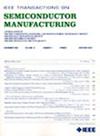RA-UNet: A New Deep Learning Segmentation Method for Semiconductor Wafer Defect Analysis on Fine-Grained Scanning Electron Microscope (SEM) Images
IF 2.3
3区 工程技术
Q2 ENGINEERING, ELECTRICAL & ELECTRONIC
引用次数: 0
Abstract
In the rapidly evolving field of semiconductor manufacturing, the escalating complexity of integrated circuits poses significant challenges in identifying and analyzing defects, crucial for maintaining high wafer yield. Traditional approaches are hindered by the intricate nature of defect morphology and the scarcity of high-quality scanning electron microscope (SEM) data, essential for effective algorithm training. In this study, we propose RA-UNet for fine-grained SEM defect segmentation. RA-UNet adopts a U-shaped architecture that leverages residual networks for defect feature extraction, and introduces a residual architecture and a novel attention module to enhance the network’s focus on defects. To validate the effectiveness of the proposed model, we meticulously gathered and labeled a real SEM data set from a semiconductor manufacturing factory. The results demonstrate that RA-UNet outperforms existing methods in semiconductor defect segmentation, achieving an Intersection over Union (IoU) score of 71.92%. These findings highlight its potential as an effective tool for semiconductor defect analysis.RA-UNet:一种新的深度学习分割方法,用于细粒度扫描电镜(SEM)图像的半导体晶圆缺陷分析
在快速发展的半导体制造领域,集成电路的复杂性不断上升,在识别和分析缺陷方面提出了重大挑战,这对于保持高晶圆产量至关重要。传统的方法受到缺陷形态的复杂性和高质量扫描电子显微镜(SEM)数据的缺乏的阻碍,而这些数据对于有效的算法训练至关重要。在这项研究中,我们提出了RA-UNet用于细粒度SEM缺陷分割。RA-UNet采用u型架构,利用残差网络进行缺陷特征提取,并引入残差架构和新颖的关注模块,增强网络对缺陷的关注。为了验证所提出模型的有效性,我们精心收集并标记了来自半导体制造工厂的真实SEM数据集。结果表明,RA-UNet在半导体缺陷分割方面优于现有方法,实现了71.92%的交集超过联盟(IoU)分数。这些发现突出了它作为半导体缺陷分析的有效工具的潜力。
本文章由计算机程序翻译,如有差异,请以英文原文为准。
求助全文
约1分钟内获得全文
求助全文
来源期刊

IEEE Transactions on Semiconductor Manufacturing
工程技术-工程:电子与电气
CiteScore
5.20
自引率
11.10%
发文量
101
审稿时长
3.3 months
期刊介绍:
The IEEE Transactions on Semiconductor Manufacturing addresses the challenging problems of manufacturing complex microelectronic components, especially very large scale integrated circuits (VLSI). Manufacturing these products requires precision micropatterning, precise control of materials properties, ultraclean work environments, and complex interactions of chemical, physical, electrical and mechanical processes.
 求助内容:
求助内容: 应助结果提醒方式:
应助结果提醒方式:


